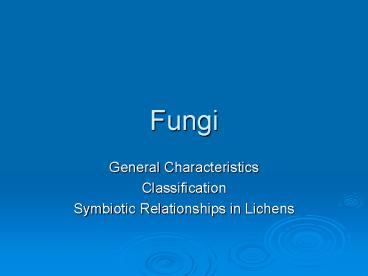Fungi - PowerPoint PPT Presentation
1 / 14
Title:
Fungi
Description:
... Mat of hyphae = mycelium Histoplasma capsulatum Able to change form in response to changes in environment Grows as mycelium on ground Invades human: ... – PowerPoint PPT presentation
Number of Views:125
Avg rating:3.0/5.0
Title: Fungi
1
Fungi
- General Characteristics
- Classification
- Symbiotic Relationships in Lichens
2
General Characteristics
- Eukaryotic
- Nonphotosynthetic
- Most are multicellular heterotrophs
- Most are microscopic molds or yeasts
- Have filaments called hyphae
- Cell walls contain chitin (also found in
insects) distinguishes them from plants (cell
walls of cellulose)
- Microscopic to 861,000 ft2
- Study of fungi mycology
- Feeding secrete enzymes then absorb digested
nutrients through cell wall - Store energy as glycogen
- Most are saprophytic (recyclers!)
3
Most fungi are
- Molds
- Tangled masses of filaments of cells
- Ex. Fungus that grows on bread and oranges
- Yeasts
- Unicellular organisms
- Colonies resemble those of bacteria
- Best known as microorganisms that make bread rise
4
Structure of Fungi
Mycelia
Rhizoids
5
Structure (cont.)
- Hyphae form mat called mycelium (see next slide)
- Divided hyphae called septate hyphae
- Non-septate hyphae are called coenocytic hyphae
- Hyphae grow by cell division at the tip,
increasing mycelium - Some can change form due to changes in
environment (see Histoplasma capsulatum, page 544
changes from mycelium to unicellular yeast due
to temperature/nutrient availability in human)
6
Mat of hyphae mycelium
7
Histoplasma capsulatum
- Able to change form in response to changes in
environment - Grows as mycelium on ground
- Invades human increase in temperature
available nutrients cause - it to grow unicellularly
8
Reproduction
-most reproduce both sexually and asexually
- Asexual
- Fragmentation
- Septate hypha dries and shatters releases
individual cells that act as spores - Budding
- pinches off to produce a small offspring cell
- Sporangiophores
- Hyphae look like stalks
- Top has enclosing sac filled with sporangiospores
- Conidiophores
- No enclosing sac around conidia
9
Reproduction (cont.)
- Sexual
- Neither male nor female, but or -
- When and - of same species encounter,
hyphae fuse then give rise to structure that
produces and scatters genetically diverse spores - Most are haploid throughout most of their life
cycle
10
Phylum Zygomycota
- Most are terrestrial organisms
- Hyphae are coenocytic
- Rhizopus stolonifer
- Hyphae anchor mold to surface
- Hyphae that penetrate surface are called Rhizoids
- Hyphae that grow across the surface of bread are
called Stolons - Reproduction
- Congugation 2 compatible mating types meet
hyphae via gametangium - Gametantium from both hyphae contain nucleus from
mating type - Gametangia fuse
- Nuclei mix and fuse in pairs
- Now Zygosporangium
- Becomes dormant
- Good conditions
- sproangiophore
- grows, producing
- sporangium ruptures
- and releases haploid
- spores
11
Phylum Basidiomycota
- Club Fungi
- Form basidiaclublike reproductive structures
during sexual reproduction (see ?) - Basidiocarp
- Spore-bearing
- Mushrooms stalk cap
- Underside of cap gills lined with dikaryotic (2
nuclei) basidia. - Nuclei fuse to form zygote (2n) zygote undergoes
meiosis4 haploid - 4 basidiospores, released into air good
conditionsthey germinate - and form mycelia that grow underground if
compatible mating types - meet, their haploid hyphae fuse and form a
basidiocarp which -
appears above ground
12
Phylum Ascomycota
- Have saclike compartments where sexually
- produced spores form
- Sac Fungi
- Live parasitically
- Habitats include salt water, fresh water, and
land - Reproduction
- Hyphae of 2 types form male and female haploid
gametangia - Maleantheridium femaleascogonium
- Gametangia unite via a tube nuclei from male
move to female dikaryotic hyphae - grow out of the female and intertwine with the
original (parent) monokaryotic - hyphae, forming ascocarp cells are monokaryotic
- Ascocarp sacs called asci
- Saccharomyces cerevisiae
- (traditional brewers
- and bakers yeast)
- Make bread rise,
- ferments grapes,
- makes beer
13
Fungi imperfecti
- Fungi that do not have a sexual stage
- deuteromycota
- Most of the species of fungi that were formerly
classified in this group, are now classified in
the phylum Ascomycota
14
Mycorrhizae and Lichens
- Compare and contrast (using page 549)
- - Make sure to identify the 3 types of lichens
- - Make sure to know which phyla form mycorrhizae
and to which lichens belong

